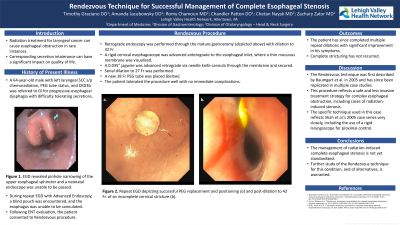Sunday Poster Session
Category: Interventional Endoscopy
P1119 - Rendezvous Technique for Successful Management of Complete Esophageal Stenosis
Sunday, October 27, 2024
3:30 PM - 7:00 PM ET
Location: Exhibit Hall E

Has Audio
- TG
Timothy Graziano, DO
Lehigh Valley Health Network
Allentown, PA
Presenting Author(s)
Timothy Graziano, DO1, Amanda Jacubowsky, DO1, Romy Chamoun, MD1, Chandler Patton, DO1, Zachary Zator, MD2, Chetan Nayak, MD1
1Lehigh Valley Health Network, Allentown, PA; 2Eastern Pennsylvania Gastrointestinal and Liver Specialists, Allentown, PA
Introduction: Radiation treatment for laryngeal cancer can precipitate esophageal obstruction in rare instances. Corresponding secretion intolerance can have a significant impact on a patient’s quality of life. Here, we present a case of complete esophageal stenosis that was successfully treated with Rendezvous procedure involving retrograde endoscopy and ENT-assisted esophageal intubation.
Case Description/Methods: A 64-year-old male with a history of left laryngeal squamous cell carcinoma status post chemo-radiation, PEG tube status, and CKD3b was referred to GI for difficulty tolerating oral secretions and progressive esophageal dysphagia. He underwent an EGD, and multiple attempts to intubate the esophageal lumen were unsuccessful as a blind pouch was encountered at the expected level of the upper esophageal sphincter. This was consistent with complete esophageal stenosis and the procedure was aborted. ENT performed a repeat laryngoscopy with confirmation of no cancer recurrence. The patient opted to undergo Rendezvous procedure for esophageal stricture dilation. Retrograde endoscopy was performed through the mature gastrostomy site with subsequent dilation to 32 Fr. A rigid cervical esophagoscope was advanced to the esophageal inlet, where a thin mucuous membrane was visualized. A 0.035” jagwire was advanced retrograde via needle knife cannula through the membrane, passed through the oral cavity, and secured. Serial dilation with dilators from 15 to 27 Fr was performed and a new PEG tube was placed. The patient has since completed numerous repeat dilations with significant improvement in his symptoms and no recurrence of complete stricturing.
Discussion: The Rendezvous technique was first demonstrated by Baumgart et al. in 2005 and reflects a new, safe, minimally invasive treatment for complex esophageal obstruction. It has since gained traction and is now described in multiple case series. This patient was originally offered laryngeal reconstruction and opted to proceed with Rendezvous, the latter being a more conservative strategy. The specific technique employed in this case reflects Shah et al.’s 2005 case series very closely, including the use of a rigid laryngoscope for proximal control. Overall, this case highlights the Rendezvous approach as a minimally invasive alternative for cases of radiation-precipitated complete esophageal stenosis. As treatments for this condition are not yet standardized, further study of this technique and alternative techniques is warranted.
Disclosures:
Timothy Graziano, DO1, Amanda Jacubowsky, DO1, Romy Chamoun, MD1, Chandler Patton, DO1, Zachary Zator, MD2, Chetan Nayak, MD1. P1119 - Rendezvous Technique for Successful Management of Complete Esophageal Stenosis, ACG 2024 Annual Scientific Meeting Abstracts. Philadelphia, PA: American College of Gastroenterology.
1Lehigh Valley Health Network, Allentown, PA; 2Eastern Pennsylvania Gastrointestinal and Liver Specialists, Allentown, PA
Introduction: Radiation treatment for laryngeal cancer can precipitate esophageal obstruction in rare instances. Corresponding secretion intolerance can have a significant impact on a patient’s quality of life. Here, we present a case of complete esophageal stenosis that was successfully treated with Rendezvous procedure involving retrograde endoscopy and ENT-assisted esophageal intubation.
Case Description/Methods: A 64-year-old male with a history of left laryngeal squamous cell carcinoma status post chemo-radiation, PEG tube status, and CKD3b was referred to GI for difficulty tolerating oral secretions and progressive esophageal dysphagia. He underwent an EGD, and multiple attempts to intubate the esophageal lumen were unsuccessful as a blind pouch was encountered at the expected level of the upper esophageal sphincter. This was consistent with complete esophageal stenosis and the procedure was aborted. ENT performed a repeat laryngoscopy with confirmation of no cancer recurrence. The patient opted to undergo Rendezvous procedure for esophageal stricture dilation. Retrograde endoscopy was performed through the mature gastrostomy site with subsequent dilation to 32 Fr. A rigid cervical esophagoscope was advanced to the esophageal inlet, where a thin mucuous membrane was visualized. A 0.035” jagwire was advanced retrograde via needle knife cannula through the membrane, passed through the oral cavity, and secured. Serial dilation with dilators from 15 to 27 Fr was performed and a new PEG tube was placed. The patient has since completed numerous repeat dilations with significant improvement in his symptoms and no recurrence of complete stricturing.
Discussion: The Rendezvous technique was first demonstrated by Baumgart et al. in 2005 and reflects a new, safe, minimally invasive treatment for complex esophageal obstruction. It has since gained traction and is now described in multiple case series. This patient was originally offered laryngeal reconstruction and opted to proceed with Rendezvous, the latter being a more conservative strategy. The specific technique employed in this case reflects Shah et al.’s 2005 case series very closely, including the use of a rigid laryngoscope for proximal control. Overall, this case highlights the Rendezvous approach as a minimally invasive alternative for cases of radiation-precipitated complete esophageal stenosis. As treatments for this condition are not yet standardized, further study of this technique and alternative techniques is warranted.
Disclosures:
Timothy Graziano indicated no relevant financial relationships.
Amanda Jacubowsky indicated no relevant financial relationships.
Romy Chamoun indicated no relevant financial relationships.
Chandler Patton indicated no relevant financial relationships.
Zachary Zator indicated no relevant financial relationships.
Chetan Nayak indicated no relevant financial relationships.
Timothy Graziano, DO1, Amanda Jacubowsky, DO1, Romy Chamoun, MD1, Chandler Patton, DO1, Zachary Zator, MD2, Chetan Nayak, MD1. P1119 - Rendezvous Technique for Successful Management of Complete Esophageal Stenosis, ACG 2024 Annual Scientific Meeting Abstracts. Philadelphia, PA: American College of Gastroenterology.
